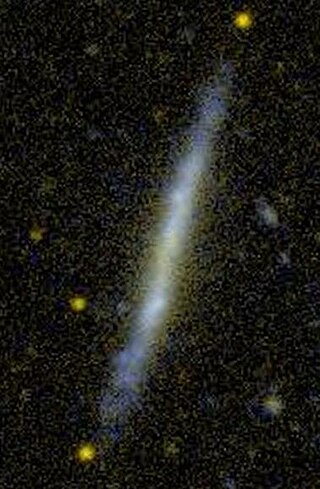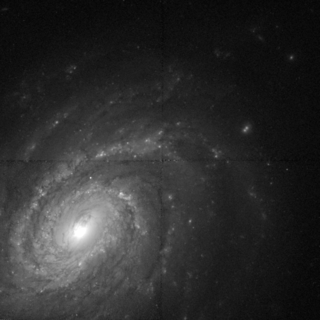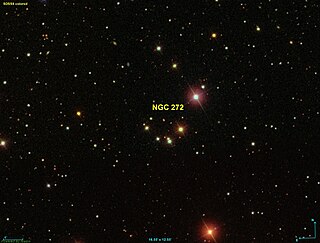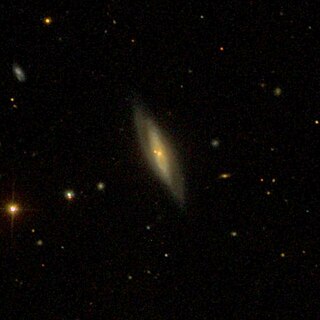
The Local Group is the galaxy group that includes the Milky Way. It has a total diameter of roughly 3 megaparsecs (10 million light-years; 9×1019 kilometres), and a total mass of the order of 2×1012 solar masses (4×1042 kg). It consists of two collections of galaxies in a "dumbbell" shape; the Milky Way and its satellites form one lobe, and the Andromeda Galaxy and its satellites constitute the other. The two collections are separated by about 800 kiloparsecs (3×10^6 ly; 2×1019 km) and are moving toward one another with a velocity of 123 km/s. The group itself is a part of the larger Virgo Supercluster, which may be a part of the Laniakea Supercluster. The exact number of galaxies in the Local Group is unknown as some are occluded by the Milky Way; however, at least 80 members are known, most of which are dwarf galaxies.

NGC 3607 is a small but fairly bright lenticular galaxy in the equatorial constellation of Leo, about 2.5° south of the prominent star Delta Leonis. The galaxy was discovered March 14, 1784 by William Herschel. Dreyer described it as "very bright, large, round, very much brighter middle, 2nd of 3". It is located at a distance of 73 million light years and is receding with a radial velocity of 930 km/s. The galaxy lies southwest of NGC 3626 at an angular separation of ~50′. It occupies the center of the Leo II Group of galaxies, forming one of its two brightest members – the other being NGC 3608. It is a member of the NGC 3607 Group of galaxies, which is a member of the Leo II Groups, a series of galaxies and galaxy clusters strung out from the right edge of the Virgo Supercluster.

NGC 5229 is an edge-on spiral galaxy located in the constellation Canes Venatici. It is a member of the M51 Group although in reality it is relatively isolated from other galaxies. The galaxy's disc is somewhat warped and appears to consist of a series of interconnected clusters of stars from our vantage point on Earth. It is approximately 7 kiloparsecs in diameter and is about 13.7 billion years old.

NGC 5286 is a globular cluster of stars located some 35,900 light years away in the constellation Centaurus. At this distance, the light from the cluster has undergone reddening from interstellar gas and dust equal to E(B – V) = 0.24 magnitude in the UBV photometric system. The cluster lies 4 arc-minutes north of the naked-eye star M Centauri. It was discovered by Scottish astronomer James Dunlop, active in Australia, and listed in his 1827 catalog.

NGC 613 is a barred spiral galaxy located 67 million light years away in the southern constellation of Sculptor. This galaxy was discovered in 1798 by German-English astronomer William Herschel, then re-discovered and catalogued by Scottish astronomer James Dunlop. It was first photographed in 1912, which revealed the spiral form of the nebula. During the twentieth century, radio telescope observations showed that a linear feature in the nucleus was a relatively strong source of radio emission.

NGC 178 is a Magellanic spiral galaxy in the constellation of Cetus. The compiler of the New General Catalogue, John Louis Emil Dreyer noted that NGC 178 was "faint, small, much extended 0°, brighter middle". It was discovered on November 3, 1885 by Ormond Stone.

NGC 199 is a lenticular galaxy located in the constellation Pisces. It was discovered on September 24, 1862, by Heinrich Louis d'Arrest.

NGC 214 is a spiral galaxy in the northern constellation of Andromeda, located at a distance of 194 megalight-years from the Milky Way. It was discovered on September 10, 1784 by William Herschel. The shape of this galaxy is given by its morphological classification of SABbc, which indicates a weak bar-like structure (SAB) at the core and moderate to loosely-wound spiral arms (bc).

NGC 266 is a massive barred spiral galaxy in the constellation Pisces. NGC 266 is located at a distance of 197 megalight-years from the Milky Way. It was discovered on September 12, 1784, by William Herschel. The form of this barred galaxy is described by its morphological classification of SB(rs)ab, which indicates a quasi-ring-like structure (rs) and moderate-to-tightly wound spiral arms (ab). It is the dominant member of a small group with six low-mass galaxies.

NGC 272 is an open cluster located in the constellation Andromeda. It was discovered on August 2, 1864 by Heinrich d'Arrest.

NGC 273 is an edge-on lenticular galaxy in the constellation Cetus. It was discovered on September 10, 1785 by William Herschel.

NGC 274 is a lenticular galaxy in the constellation Cetus. It is a pair of galaxies, the other being NGC 275, which it is currently interacting with. It was discovered on September 10, 1785 by William Herschel. It is roughly 120 million light-years away.

NGC 333 is a lenticular galaxy located approximately 755 million light years away in the constellation Cetus. It was discovered in 1877 by Wilhelm Tempel. It is recorded as NGC 333 in the New General Catalogue. It has a companion galaxy, named PGC 3073571, which is presumed to be a physical pair with NGC 333.

NGC 349 is a lenticular galaxy in the constellation Cetus. It was discovered on September 27, 1864 by Albert Marth. It was described by John Louis Emil Dreyer as "very faint, very small."

NGC 353 is a spiral galaxy in the constellation Cetus. It was discovered on November 10, 1885 by Lewis Swift. It was described by Dreyer as "extremely faint, pretty small, round, southeastern of 2.", the other being NGC 351.

NGC 357 is a barred lenticular or spiral galaxy in the constellation Cetus. It was discovered on September 10, 1785 by William Herschel. It was described by Dreyer as "faint, small, irregularly round, suddenly brighter middle, 14th magnitude star 20 arcsec to northeast."

NGC 366 is an open cluster located in the constellation Cassiopeia. It was discovered on October 27, 1829 by John Herschel. It was described by Dreyer as a "cluster, small."

NGC 5084 is a lenticular galaxy in the constellation of Virgo. It is located at a distance of circa 80 million light years from Earth, which, given its apparent dimensions, means that NGC 5084 is at least 200,000 light years across. It is one of the largest and most massive galaxies in the Virgo Supercluster. It was discovered by William Herschel on March 10, 1785. It is a member of the NGC 5084 Group of galaxies, which is a member of the Virgo II Groups, a series of galaxies and galaxy clusters strung out from the southern edge of the Virgo Supercluster. The galaxy is seen nearly edge-on, with inclination 86°, and features a warped disk and large quantities of HI gas extending along the disk, probably accumulated after multiple accretions of smaller galaxies.

NGC 7184 is a barred spiral galaxy located in the constellation Aquarius. It is located at a distance of circa 100 million light years from Earth, which, given its apparent dimensions, means that NGC 7184 is about 175,000 light years across. It was discovered by William Herschel on October 28, 1783.

NGC 6951 is a barred spiral galaxy located in the constellation Cepheus. It is located at a distance of about 75 million light-years from Earth, which, given its apparent dimensions, means that NGC 6951 is about 100,000 light-years across. It was discovered by Jérôme Eugène Coggia in 1877 and independently by Lewis Swift in 1878.




















